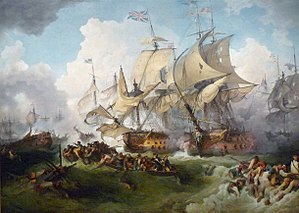Lord Howe's action, or the Glorious First of June
| Lord Howe's action, or the Glorious First of June | |
|---|---|
 |
|
| Artist | Philippe-Jacques de Loutherbourg |
| Year | 1795 |
| Medium | Oil on canvas |
| Dimensions | 266.5 cm × 373.5 cm (104.9 in × 147.0 in) |
| Location | Queen's House (NMM), London |
Lord Howe's action, or the Glorious First of June is a 1795 painting by Philippe-Jacques de Loutherbourg of the victory of British naval forces under Lord Howe over a French force led by Louis Thomas Villaret de Joyeuse on the Glorious First of June 1794. After time in the Royal Collection of George IV, it is currently in the collection of the National Maritime Museum and on display in the ground floor of its Queen's House, in place of Turner's The Battle of Trafalgar (whilst the latter is on long-term foreign loan).
The painting was commissioned by V. and R. Green and Christian von Mechel, engravers and publishers, for £500. They had in 1793 commissioned the equally large "The Siege of Valenciennes" from him, and this painting of the naval battle was intended to accompany it. Both paintings were intended for engraving (prints of them were produced by James Fittler, with 'Glorious First' coming out in January 1799 and 'Valenciennes' in 1801) and public exhibition (from 2 March 1795 at the Historic Gallery, Pall Mall, thus garnering interest for the images' publication, and on tour after their sale to Mr T. Vernon of Liverpool in 1799). James Gillray, as with Louthebourg's 'Valenciennes', gave Louthebourg help with painting the figures (Gillray had accompanied the army carrying out the siege).
Shown at Edinburgh in 1800, Vernon later sold them separately, with the 'Valenciennes' eventually finishing up in Lord Hesketh's collection at Easton Neston. The 'Glorious First' was purchased early in the 19th century for the Royal Collection by the Prince of Wales, who displayed it at St James's Palace and - after his accession to the throne in 1820 - commissioned JMW Turner's The Battle of Trafalgar as a pendant for it. However, Turner's piece was criticised for perceived factual inaccuracies, and so George gave both the 'Trafalgar' and 'Glorious First' to the Naval Gallery at Greenwich Hospital in 1829 as one of his last gifts to them.
...
Wikipedia
